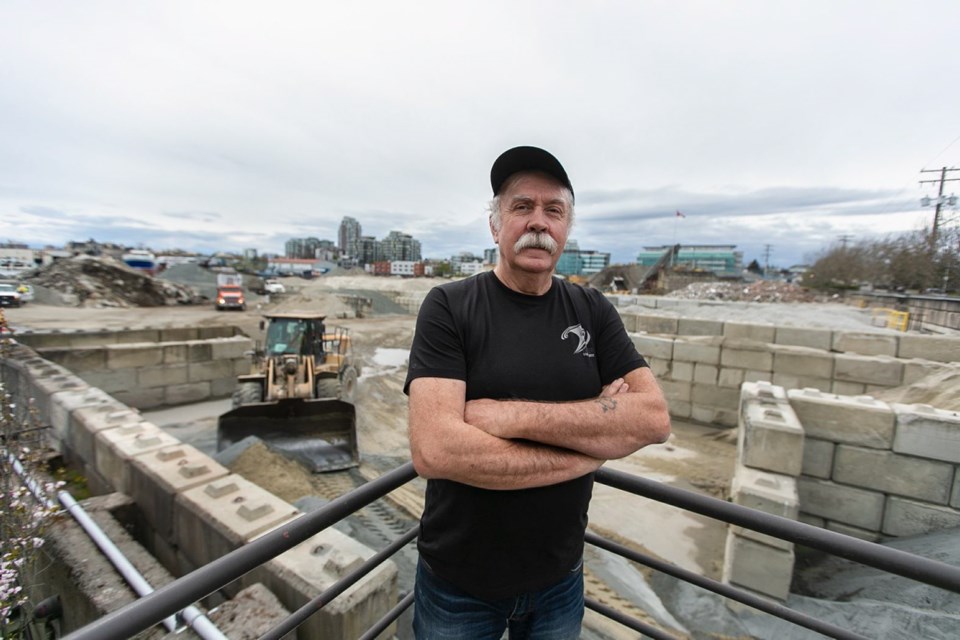Development pressure and demand for land for housing projects have some heavy-industry users and landowners concerned about the shrinking size of the region’s industrial land base.
It’s even got one industrial landowner mulling the idea of an industrial land reserve, to mirror the one set up for agriculture.
“I’d at least like to start the conversation,” said Ian Maxwell, president of the Ralmax Group of companies.
Maxwell’s operations — Point Hope Shipyard, Trio Ready-Mix, Chew Excavating, Salish Sea Industrial, Ellice Recycling and United Engineering — sit on 24 acres of land around Victoria Harbour and Rock Bay. For years, he said, the industrial land around the harbour has diminished to make way for condominiums and commercial development.
Maxwell said there needs to be a mix, but when industrial land disappears, it’s gone forever. With it go good-paying jobs and the kind of industry that fuels growth.
“This is not just a local problem — it’s a provincial problem, maybe a 91原创 problem,” said Maxwell, adding his chief concern is that in the rush to find property for housing projects, municipalities might not consider the long-term consequences of taking away industrial land. “They may not understand the subtleties of those [industrial] sites.”
Maxwell said he has been asked many times why he couldn’t move his operations to places such as Sooke. But he learned early on that Point Hope sits on a protected deep-water site, ideal for their work, and they simply couldn’t get vessels to a site in Sooke.
Industrial lands can also be subject to the complaints of new developments springing up around them, he said, arguing decisions should be in the hands of a higher power than municipal councils.
“This can’t be up to the whim of a municipal politician,” he said. “We have lost so much industrial land. We need to have something between the municipality and the province to make decisions about the removal of job-creating lands, a board that asks the questions about why those lands are there. Some of those lands are irreplaceable, like Point Hope. And everybody needs a paycheque — generating paycheques is one of the things that stabilizes our society.”
Industrial lands are in “critical under-supply,” said Ty Whittaker of Colliers International’s Victoria office. “I’ve had [users representing] about 200,000 square feet of [land] requirement floating around in the marketplace and there are very few options for them to choose from,” he said. “Most of the traditional industrial areas are full. It’s harder right now to find industrial space than it is to find an apartment downtown.”
Vacancy rates for industrial land have dropped to a decade low of 1.7 per cent in the region, down from 2.4 per cent in 2017. Colliers expects that low vacancy rate to continue for the foreseeable future.
Whittaker said Keating Industrial Park, Royal Oak and Rock Bay are all full, which has pushed industrial users out to the West Shore. Some companies ready to expand are starting to feel choked off by the lack of space.
“A lot of companies want to be in this marketplace, and for no fault of their own, there are no options for them to consider, and that can mean waiting for a full year,” Whittaker said. “That’s not good for business, job creation or for the overall economy.”
Mel Sangha, general manager of OK Industries, a 75-year-old asphalt, paving and rock-crushing firm, agreed many communities don’t seem to understand the value of industrial land. “I wonder if they understand the value in terms of living wages and the ripple effect of funding families and the effect that has throughout the community,” said Sangha, whose company employs 250 people at its peak in the summer.
OK Industries has an asphalt plant on five acres downtown on the water looking across from Point Hope Shipyard, a spot that Sangha said is ideal, as it’s central and accessible for municipalities and private clients.
Sangha said if the company was pushed out of the city, clients such as the City of Victoria would be paying significantly more for the product, and traffic and greenhouse-gas emissions would increase. Sangha said the company has been approached many times about selling the downtown site. While the money has been attractive, he points out there’s nowhere to move the operation that makes sense.
Victoria Mayor Lisa Helps said she understands the importance of industrial land, and while it is difficult to turn back the clock and reclaim land that has been developed, the city is working to preserve what it has.
“The City of Victoria official community plan strongly protects industrial land. If we want to have an economy, we need to have land for the economy,” she said.
She called the idea of an industrial land reserve “really interesting,” though she was quick to point out it shouldn’t be government setting it up and administering it.
“We have community land trusts for housing and farmland trusts for farmland, so if we want to have an economy here into the future, it’s an idea worth exploring,” she said.
Whittaker isn’t sold on an industrial land reserve, but he does think some municipalities have to start identifying industrial parcels and setting them aside.
Langford Mayor Stew Young has tried to do just that.
“We have probably lost about 10 acres of industrial land over the last 10 years, and I don’t like to lose it,” he said, noting those lands represent good jobs. “They are probably the highest-paying jobs I have.”
Young said everyone likes the high-tech industry, but cities need a mix of industries.
To that end, as he felt pressure was building on the industrial land base a couple of years ago, Young made a land-swap deal with Metchosin and Beecher Bay First Nation that resulted in a business park straddling the Langford-Metchosin border.
He said if any more industrial land is lost as the West Shore continues to feel pressure to build housing, more will be added to the mix.



